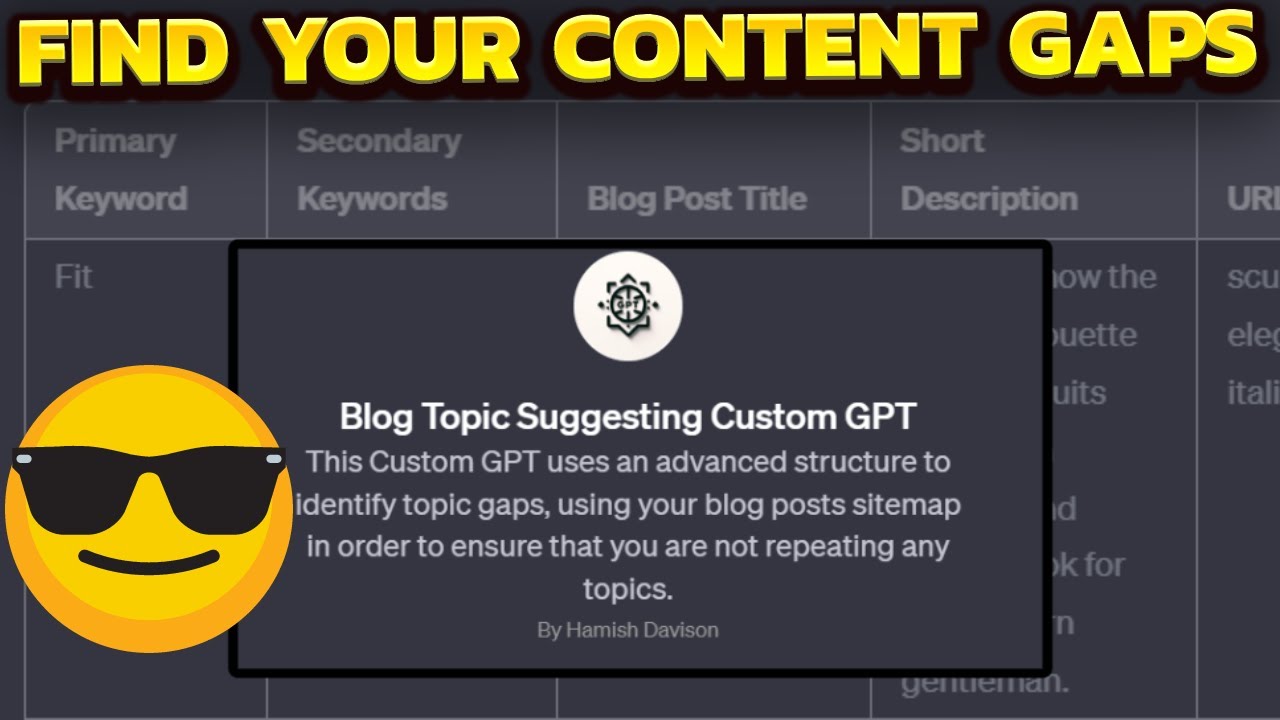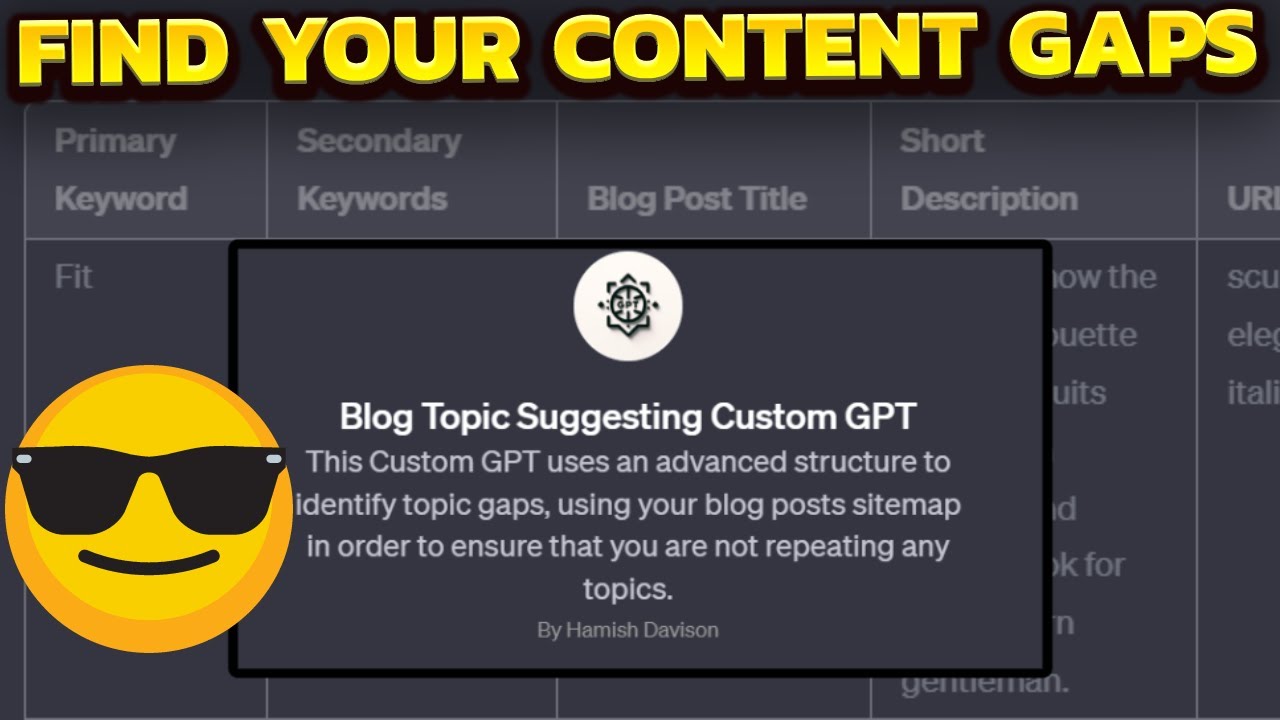In the video by Income Stream Surfers, they introduce a CustomGPT tool for SEO that does keyword research for you. They mention that the tool may not work perfectly all the time, so multiple attempts may be required. The CustomGPT works by asking for the website and researching it on Bing, gathering information about its purpose and strategy. Then, it asks for a list of the user’s articles and current categories or collections. Using this information, the tool generates 5 potential keywords for article writing. Approval is sought for these keywords and related keywords collected from Bing searches. A sample table of blog post ideas is created, and the user has the option to expand it with 20 more rows using sitemaptoclipboard to gather more data. This tool proves to be helpful in finding content gaps in established websites and assists in SEO content planning. You can use it for your own website or for competitor analysis to gain topic ideas and improve your SEO strategy.
After the success of their previous video, Income Stream Surfers are back with another Custom GPT for SEO. This time they focus on keyword research and finding content gaps. The video explains the process of using the CustomGPT, starting with inputting the website and analyzing it along with blog posts and collections. The tool generates 5 potential keywords and collects related keywords from Bing searches. It also creates a sample table of blog post ideas. The video emphasizes that this tool is beneficial for both personal websites and competitor analysis, providing valuable insights and ideas for content creation. So if you’re looking to optimize your SEO strategy and discover new topics, give the CustomGPT a try!
Using CustomGPT for Keyword Research in SEO
Introduction to CustomGPT tool
CustomGPT is a powerful tool that can greatly assist in the keyword research process for SEO. It is designed to analyze a website, understand its purpose and strategy, and generate potential keywords that can be used for article writing. This tool saves time and effort by automating the keyword research process and providing valuable insights for content creation.
How CustomGPT works
CustomGPT works by first asking for the website you are writing for, then researching the website on Bing to gather information about its purpose. It analyzes user-provided articles and categories to understand the website’s strategy. Based on this analysis, it generates 5 potential keywords and seeks approval for these keywords. Once approved, it searches for related keywords on Bing and collects them for further keyword research.
Steps for Keyword Research using CustomGPT
-
Providing Website and Article Information: Start by inputting the website you are writing for and sharing a list of the website’s articles. You can use the “sitemaptoclipboard” tool to easily gather a list of URLs.
-
Analyzing Website and Blog Content: CustomGPT analyzes the website and blog content to gain a deeper understanding of the website’s strategy and niche.
-
Generating Potential Keywords: Based on the analysis, CustomGPT generates 5 potential keywords that are relevant to the website’s content.
-
Evaluating Relevance and Competition: The generated keywords are then evaluated for relevance and competition. This helps in determining the viability of using these keywords for content creation.
-
Refining the List of Keywords: After evaluating the keywords, the list can be refined further by narrowing down the keywords that are most relevant and have the least competition.
Analyzing Website’s Strategy
Analyzing a website’s strategy is an essential step in keyword research. It helps in identifying the target audience, understanding the website’s niche, and assessing competitor analysis. By understanding the website’s strategy, CustomGPT can generate more accurate and relevant keywords that align with the website’s overarching goals.
Generating Potential Keywords
CustomGPT utilizes its keyword generation capabilities to generate potential keywords for content creation. It combines the information gathered from analyzing the website with Bing search results to ensure a comprehensive list of potential keywords. By exploring relevant keywords, CustomGPT ensures that the generated keywords are aligned with the website’s content and target audience.
Seeking Approval for Keywords
Before proceeding with content creation, it is important to seek approval for the generated keywords. This step allows for feedback and suggestions, ensuring that the selected keywords align with the website’s goals and objectives. By collecting feedback and obtaining approval, the content creation process can proceed with confidence.
Creating a Sample Table of Blog Post Ideas
To organize the generated keywords and facilitate the content planning process, CustomGPT suggests creating a sample table of blog post ideas. This table includes columns for primary and secondary keywords, blog post titles, short descriptions, and URL slugs. The sample table serves as a blueprint for content creation and provides a clear structure for generating high-quality articles.
Expanding the Table for More Data
If desired, the sample table can be expanded by adding 20 more rows. To gather more data for the expanded table, the sitemaptoclipboard tool can be utilized. This tool helps in gathering a comprehensive list of the website’s current blog posts and collections, providing CustomGPT with more data to work with for keyword research and content gap analysis.
Finding Content Gaps with CustomGPT
One of the key benefits of using CustomGPT is its ability to find content gaps in an established website. By analyzing the website’s content and conducting competitor analysis, CustomGPT can identify areas where additional content can be created to fill these gaps. This ensures that the website remains competitive and offers a comprehensive range of content to its audience.
Using CustomGPT for Competitor Analysis
CustomGPT can also be used for competitor analysis. By inputting a competitor’s website into the tool, CustomGPT can analyze the competitor’s content and strategy to identify potential content gaps that can be exploited. This provides valuable insights for creating unique and engaging content that differentiates the website from its competitors.

Conclusion
In conclusion, CustomGPT is a powerful tool that streamlines the keyword research process for SEO. By analyzing websites, generating potential keywords, and assisting in content planning, CustomGPT saves time and effort while providing valuable insights for creating high-quality content. Whether it’s for personal websites or competitor analysis, CustomGPT offers a comprehensive solution for keyword research in SEO. With its future potential and continuous improvements, CustomGPT is a valuable tool for any SEO professional or content creator.
